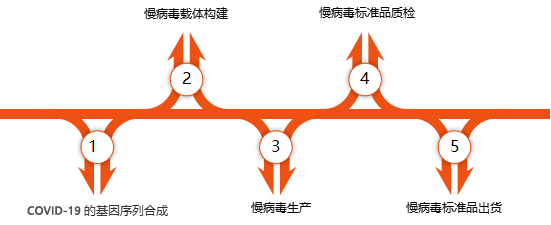Service Introduction
Currently, the standard for the detection of novel coronavirus is still based on nucleic acid detection. The nucleic acid detection experiment mainly includes the following steps: virus sample acquisition, virus nucleic acid extraction, RNA reverse cDNA, QPCR system preparation, and on-machine detection. Any of these steps will lead to test failure and unable to diagnose.
Among them, there are many types of virus nucleic acid extraction kits, and the quality is also different. The success of virus nucleic acid extraction is crucial for subsequent detection. It is very important to strictly control the kit!
IGEbio based on the gene sequence of novel coronavirus 2019-nCoV and the official announced detection targets, using the lentivirus system, developed a series of pseudovirus products, which can simulate RNA viruses specifically, and have high biological safety and reliable stability. It can be used for virus detection kit RNA standard, detection process quality control, and simulation test in the development stage of the kit, and has a wide range of applications.
Features of Pseudovirus Standard
1. The gene sequences of each part of the novel coronavirus are synthesized and cloned into the lentivirus vector, and the pseudovirus is prepared in 293T cells. The pseudovirus obtained is the RNA sequence of the gene contained in the lentivirus genome. It can be used as a control for virus RNA extraction experiments and qPCR detection experiments.
2. Since the nucleic acid sequence of the novel coronavirus is about 29kb to 30kb, and the lentivirus vector can generally only accommodate no more than 4kb of exogenous gene sequences. The lentivirus backbone (pLVmini-MCS) that has been modified and approved for pseudovirus patent by our company can accommodate 6.5kb of target genes (mainly for pseudovirus production), which can be used to develop stable, non-biologically infectious quality control materials and standards. It is of great significance not only for the RT-PCR detection of RNA viruses, but also for the evaluation of commercialized virus RT-PCR kits.
3. Using a unique method for removing plasmid residues, the plasmid residue content in the pseudovirus is not more than 3% of the RNA content (no specific detection data is provided, still under testing).
Technical advantages
No autonomous replication ability
No pathogenicity, good safety
High preparation efficiency, high purity
Strong operability
Accurate and reliable quality control methods
Can be prepared in large quantities for a long time
Low plasmid residue
Procedures

Flow service diagram


